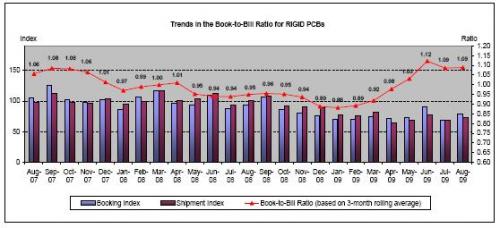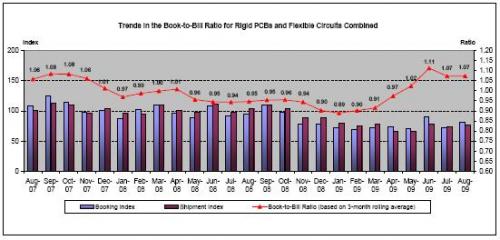IPC: NA PCB Industry’s August Book-to-Bill Ratio Above Parity
IPC – Association Connecting Electronics Industries® has announced the August findings from its monthly North American Printed Circuit Board (PCB) Statistical Program.
Rigid PCB shipments declined 27.4 percent and bookings were down 13.0 percent in August 2009 from August 2008. Year to date, rigid PCB shipments were down 28.7 percent and bookings fell by 26.9 percent. Compared to the previous month, rigid PCB shipments grew by 4.8 percent and rigid bookings increased 12.2 percent. The book-to-bill ratio for the North American rigid PCB industry in August 2009 remained above parity at 1.09.
Flexible circuit shipments in August 2009 went down 13.7 percent and bookings increased 7.5 percent compared to August 2008. Year to date, flexible circuit shipments were down 2.7 percent and bookings were down 7.3 percent. Compared to the previous month, flexible circuit shipments went up 2.1 percent and flex bookings increased 26.5 percent. The North American flexible circuit book-to-bill ratio in August 2009 fell back to 0.92.
For rigid PCBs and flexible circuits combined, industry shipments in August 2009 decreased 26.5 percent from August 2008 and orders booked decreased 11.7 percent from August 2008. Year to date, combined industry shipments were down 27.0 percent and bookings were down 25.7 percent. Compared to the previous month, combined industry shipments for August 2009 increased 4.5 percent and bookings went up 13.1 percent. The combined (rigid and flex) industry book-to-bill ratio in August 2009 held steady at 1.07.
“It’s slow going, but we’re seeing more signs of recovery in the North American PCB industry,” said IPC President Denny McGuirk. “Rigid PCB bookings are strengthening and that is keeping the book-to-bill ratio well above parity. It has been positive now for four consecutive months, which suggests that we should start to see the impact in sales growth this fall.”
The book-to-bill ratios are calculated by dividing the value of orders booked over the past three months by the value of sales billed during the same period from companies in IPC’s survey sample. A ratio of more than 1.00 suggests that current demand is ahead of supply, which is a positive indicator for sales growth over the next two to six months.
Book-to-bill ratios and growth rates for rigid PCBs and flexible circuits combined are heavily affected by the rigid PCB segment. Rigid PCBs represent an estimated 91 percent of the current PCB industry in North America, according to IPC’s World PCB Production and Laminate Market Report.
Note: The index is based on year-on-year growth rates to reflect long-term trends. It may not always appear consistent with the month-to-month changes in the data.
The Role of Domestic Production
IPC’s monthly survey of the North American PCB industry tracks bookings and shipments from U.S. and Canadian facilities, which provide indicators of regional demand. These numbers do not measure U.S. and Canadian PCB production. To track regional production trends, however, IPC asks survey participants for the percent of their reported shipments that were produced domestically (i.e., in the USA or Canada). In August 2009, 87 percent of total PCB shipments reported were domestically produced. Domestic production accounted for 88 percent of rigid PCB and 82 percent of flexible circuit shipments in August by IPC survey participants. These numbers are significantly affected by the mix of companies in IPC’s survey sample, which may change slightly in January, but are kept constant through the calendar year.
Bare Circuits versus Assembly
Flexible circuit sales typically include value-added services such as assembly, in addition to the bare flex circuits. In August, the flexible circuit manufacturers in IPC’s survey sample indicated that bare circuits accounted for approximately 70 percent of their shipment value reported for the month. Assembly and other services make up a large and growing segment of flexible circuit producers’ businesses. This figure is also sensitive to changes in the survey sample, which may occur at the beginning of each calendar year.
Interpreting the Data
Year-on-year and year-to-date growth rates provide the most meaningful view of industry growth. Month-to-month comparisons should be made with caution as they may reflect cyclical effects. Because bookings tend to be more volatile than shipments, changes in the book-to-bill ratios from month to month may not be significant unless a trend of three consecutive months or more is apparent. It is also important to consider changes in bookings and shipments to understand what is driving changes in the book-to-bill ratio.
The information in IPC’s monthly PCB industry statistics is based on data provided by a representative sample of both rigid and flexible PCB manufacturers in the USA and Canada. IPC publishes the PCB Book-to-Bill Ratio and the PCB Statistical Program Report each month. Statistics for the previous month are not available until the last week of the following month.
About IPC
IPC (www.IPC.org) is a global trade association based in Bannockburn, Ill., dedicated to the competitive excellence and financial success of its 2,700 member companies which represent all facets of the electronics industry, including design, printed board manufacturing, electronics assembly and test. As a member-driven organization and leading source for industry standards, training, market research and public policy advocacy, IPC supports programs to meet the needs of an estimated $1.7 trillion global electronics industry. IPC maintains additional offices in Taos, N.M.; Arlington, Va.; Garden Grove, Calif.; Stockholm, Sweden; Moscow, Russia; and Shanghai and Shenzhen, China.















